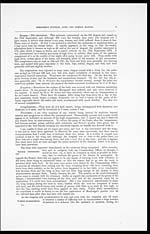Medicine - Institutions > Army health reports and medical documents > Sketch of the medical history of the native army of Bombay > Sketch of the medical history of the native army of Bombay, for the year 1872
(8) Page 8
Download files
Individual page:
Thumbnail gallery: Grid view | List view

8
SKETCH OF THE MEDICAL HISTORY OF THE NATIVE ARMY OF BOMBAY.
The table below shows the admissions and deaths from miasmatic diseases—
| Admitted. | Died. | Annual Ratio per 1,000 to Strength. | ||||||
| Admitted. | Died. | |||||||
| 1871. | 1872. | 1871. | 1872. | 1871. | 1872. | 1871. | 1872. | |
| Eruptive Fever | ... | 1 | ... | ... | ... | 3.38 | ... | ... |
| Dengue | ... | 200 | ... | ... | ... | 677.96 | ... | ... |
| Paroxysmal | 228 | 317 | ... | ... | 911.35 | 1074.57 | ... | ... |
| Dysentery and Diarrhœa | 8 | 51 | ... | ... | 32.25 | 172.88 | ... | ... |
| Sorethroat | ... | 1 | ... | ... | ... | 3.38 | ... | ... |
| Ophthalmia | 13 | 1 | ... | ... | 52.41 | 3.38 | ... | ... |
| Rheumatism | 10 | 9 | ... | ... | 40.32 | 30.50 | ... | ... |
The chief admissions during the year were from ague, dengue, dysentery and diarrhœa.
The admissions this year from intermittent fever amounted to 317.
The following table shows the proportion per mille of the admissions from ague in each
month:—
| January | February. | March. | April. | May. | June. | July. | August. | September. | October. | November. | December. | |
| Admissions | 196.39 | 111.52 | 64.93 | 78.06 | 58.82 | 51.47 | 36.63 | 87.08 | 44.91 | 101.40 | 137.93 | 113.07 |
| Deaths | ... | ... | ... | ... | ... | ... | ... | ... | ... | ... | ... | ... |
There have been no deaths. The fever was of the ordinary type. It was most frequent in
the months of January, October, November, and December, and least in May, June, and July.
I have no alterations to make in my remarks on its treatment from what I wrote last year.
I still continue to use alum as an emetic with every success.
As regards the causes of local malaria, I have but little to state. It appears to me to
act with the greatest intensity on the human system, in those situations which are low and
moist during the rains, and which when the surface begins to dry up undergo decomposition.
Such is the case in the Tanna districts. Local malaria gradually increases in October when
the rains begin to lessen, and arrives at its greatest intensity in November, after which the soil
begins to dry up, and it gradually decreases in February and March, by which time the soil
has dried up. As for the reason of its being so rife during these months, I consider it suffi-
ciently accounted for by the fact that Tanna is surrounded on all sides, except on the east and
south by rice-fields; and it is a well-known fact to the natives that as the rice-fields dry up,
ague will abound. As regards the "modus operandi" very little is known. Most probably
it enters the system by the patient's breathing an atmosphere saturated, more or less, with the
poison (that is, supposing it is a gaseous substance). It does not seem to be introduced by
drinking water, as I have known persons who drink carefully filtered water, yet suffer
from it very severely. However the latest theory is, that it is caused by the inhalation of
cryptogamic spores floating in the atmosphere: this is a very plausible one if it could be
brought to the "experimentum cruces", but like many others of a similar nature it will most
probably pass into oblivion after a few years.
The more important question to be considered is, are there any means of prevention by
sanitary measures, &c. I am of opinion that it is impossible to expect for some time to come
that the natives will ever understand the value of preventive medicine; and, until they can
understand its uses, they will never cordially accept the sanitary suggestions made for their
benefit. Take the sepoy for example: he closes every nook and corner that will allow a breath
of fresh air to enter, and would never be so happy as when he has his hut surrounded with
plantain trees, which are watered probably from the water thrown down inside his hut when
bathing.
Set display mode to: Large image | Zoom image | Transcription
Images and transcriptions on this page, including medium image downloads, may be used under the Creative Commons Attribution 4.0 International Licence unless otherwise stated. ![]()
| Permanent URL | https://digital.nls.uk/75012626 |
|---|




